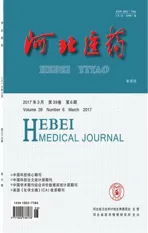射频消融在肝癌治疗中的应用进展
2017-02-26刘波罗强王洪林
刘波 罗强 王洪林
·综述与讲座·
射频消融在肝癌治疗中的应用进展
刘波 罗强 王洪林
射频消融治疗肝癌具有微创、相对安全、疗效可靠及并发症少等特点,笔者就国内外射频消融治疗肝癌的最新的应用策略、疗效对照、并发症以及对肝癌细胞的生物学行为的影响等方面进行综述,以期为临床射频治疗肝癌的应用提供参考。
射频消融;肝癌;综述
肝细胞癌是最常见的恶性肿瘤之一,复发率高,预后差,病死率仅次于肺癌和胃癌居第三位[1]。到目前为止,外科手术仍是首选的治疗手段,但总体切除率只有30%~35%[2]。目前治疗肝癌的方法有肝切除、肝移植、经皮动脉化疗栓塞术、经皮无水酒精注射、射频消融、微波及高频超声等[3-5]。肝脏肿瘤手术切除是原发性肝癌治疗策略的常规选择,然而实施肝脏外科手术需要对患者的肿瘤特征、肝功能及机体状况等进行全面的评估[6],且大部分的肝癌在诊断明确时已经不适宜进行手术切除[7]。射频消融(radiofrequency ablation,RFA)治疗作为肝癌的辅助治疗在国外20世纪90年代就有报道,Rossi等[8]在上个世纪90年代初期首先报道了其在动物上进行超声引导下射频治疗肝癌的实验,并提出小于2 cm的肝癌可通过射频进行治疗,Rossi首次在临床进行RFA治疗并取得成功,之后大量的科研人员对射频消融进行了深入的研究。射频消融目前被认为是最有效的经皮消融法,在很多的医疗中心已经成为一线的治疗策略,包括对于一些能够手术切除的病例[9]。
1 射频消融的原理
射频消融主要是通过射频发生器提供300~500 kHz 范围的交流电,通过电线连接穿刺针和贴在患者皮肤上的中性电极板组成1个射频循环体,刺入肿瘤的电极针发出的能量能激发组织中的离子振动摩擦发热而产生损毁肿瘤组织作用,此过程中随电极针周围组织的受热干燥脱水,会导致受热区组织阻抗增加降低导电性,使最终热损毁的肿瘤组织范围减少[10]。随着科学的进步和临床经验的积累,为达到足够的消融范围和治疗效果,电极针及操作程序进行了不断的改进,最初的单电极针仅能达到1.3 ml体积的组织损毁,之后通过改进发明了中空的可灌注水冷凝电极针、盐水增强电极针、伞状多电极以及复合集束电极等以使消融范围达3~5 cm以上甚至更大。
2 射频消融与肝切除术治疗的疗效对比
2.1 原发性肝癌 尽管目前认为经皮肝癌射频消融术具有相对安全、微创、操作容易、可重复性强等特点,已经广泛应用与原发性肝癌的治疗[9,11],但目前对于其疗效依然争议很大,不同的学者的研究有不同的结果。
Cho等[12]的随机对照分析结果表明<2 cm的极早期肝癌RFA能够达到手术的同等效果。Huang等[13]通过随机对照实验显示符合米兰标准的肝癌RFA组总体生存要高于手术组,但手术组的复发率要更低。肝切除术对于肿瘤结节小于2 cm的早期肝癌肝功能较好、胆红素正常且没有临床门脉高压征的患者,术后不会出现肝功能失代偿且5年生存率可达75%以上,解剖性肝切除相对于非解剖性切除效果更佳[14]。邱宝安等[15]研究表明,符合米兰标准的多发性肝癌行手术切除能够取得相对RFA高的生存率,RFA 围术期并发症的发生率及术后肝功能损害程度上优于手术组。研究表明对于2 cm以下非肝包膜下或血管周围的肝癌结节,RFA的完全消融可达到97%,5年生存率在68%。RFA几乎能达到与手术同等的效果,这也使其已经成为许多医疗中心采取的标准策略[16]。
Buscarini等[17]报道RFA治疗直径<3.5cm肝癌的1,3,5年生存率分别为89%、62%、33%,与手术治疗已经没有明显区别。Chen等[18]前瞻性随机实验对比肝癌小于5 cm直径的结节采用RFA和手术切除的方法,两者在统计学上无显著差异,而手术的并发症相对还要多一些。
2.2 转移性肝癌 通过前瞻性随机对照试验分析结果显示,孤立性的结肠癌肝脏转移在分别进行常规肝脏切除术和局部射频治疗后,肝切除组的3年和5年累计原位无复发生存率明显高于射频治疗组,但在RFA组的5年总生存率则要明显低于肝脏手术切除组[19]。Reuter等[20]对结肠癌肝转移手术治疗和射频治疗的回顾性分析显示,RFA复发的中位时间要短于切除组(分别是12.2月和31.1月),但RFA治疗组在原位复发和远处转移相比手术切除组更容易发生。
White等[21]报道结肠癌转移性肝癌开放楔形切除和RFA的总体中位生存时间分别是80个月和31个月,认为肝肿瘤切除术对于能够切除的肝癌患者仍然是首选,RFA等只能作为不适宜手术患者的辅助选择。Aloia报道[22]对于结肠癌单个肝癌转移结节手术和RFA的5年总体生存率分别是71%和27%,RFA不理想的结果与肿瘤的直径并无相关性。Hur等[23]对67例转移性肝癌中手术组和RFA组进行比较,手术组5年总生存率明显高于RFA组,分别是50.1%和25.5%,无复发生存率分别是89.7%和69.7%。然而在小于3 cm的转移性肝癌手术切除组和RFA组在5年总生存率(分别为56.1% 和 55.4%)与无复发生存率(95.7%和 85.6%)方面却无明显差异,因此建议RFA作为癌结节直径3 cm以下且因为转移性肝癌局部解剖差、术后肝储备功能不足等不适宜手术患者的替代治疗。
3 提高RFA疗效的策略
提高疗效的策略包括如设计有效降低RFA过程中阻抗的器械、减少组织温度过高的碳化以及联合其他的有效的治疗策略等。RFA要成为原发性肝癌的首选治疗策略则其原位复发率需要至少低于9%[12]。不同的学者对RFA如何降低原位复发率进行了深入研究,有报道只要有超过结节的足够的消融边界,小于3 cm的肿瘤结节RFA后原位复发率仅为2%[4]。对于小于5 cm的肿瘤结节消融边界超过4~5 mm可使肿瘤的原位复发率降低至5%以下[24-26],故有观点提出对于符合米兰标准的肝癌,RFA和肝癌切除术都可作为患者首选的治疗策略,如果RFA没有消融到足够的安全边界(4~5 mm)则可行手术补救性治疗[12,27]。在射频消融后行无水酒精注射,可以使无水酒精在热力的作用下达到射频能量无法达到的范围,从而扩大肿瘤坏死面积[28]。但在有血管或其他重要管道的位置的肿瘤联合PEI和RFA对提高肿瘤消融率收效甚微[29]。而联合TACE可使RFA的临床疗效明显得到提高,研究认为相比单独使用射频消融法,联合介入化疗栓塞的射频消融能够明显增加射频消融治疗中凝固的范围[9]。通过联合TACE[30],可以减少RFA治疗直径过大的肿瘤结节过程中减少血液流动导致热量的损失,从而提高RFA的治疗效果,降低局部肿瘤进展率[31]。
4 射频消融对肝癌的生物学影响
研究表明RFA能够通过局部的凝固性坏死刺激局部炎性反应,增加肿瘤特异性T细胞的免疫反应[32],经RFA的肝癌组织相对于未行RFA肝癌组织和正常肝组织,能够通过暴露肿瘤抗原、促进抗原提呈细胞成熟而促进肝癌特异性T细胞反应[33]。闫景彬等[34]RFA 治疗后机体抗肿瘤免疫功能短时间内有明显改善,能产生较为明显的 Th1 型免疫应答,显著提高患者机体的抗肝癌免疫功能。
实验证实不完全消融后残余肝癌细胞的增殖、转移和侵袭力在RFA后增强,Schuld等[35]研究显示通过在结肠癌肝转移模型中通过RFA、冷冻和激光等治疗后灌注离体肝脏后收集灌注液细胞,可检测到MMP-2和 MMP-9表达相对对照组不同程度地升高。体内外实验均发现RFA后造成的烧灼边缘的缺氧过渡区出现CD95和CD95L表达升高,过渡区肝癌细胞增殖加速,转移侵袭力增加[36]。Ke等[37]通过低温造成不完全消融建立兔肝癌RFA后残癌模型,发现RFA后残癌迅速增生,肺转移侵袭增加,同时检测发现相对于未行RFA癌组织,残癌PCNA、MMP-9、VEGF、HGF及IL-6等蛋白过表达,Liu等[38]通过体外模拟射频不完全消融,发现肝癌细胞VEGF表达增加而促进肝癌细胞增殖。而上皮间质转化也参与了不完全消融后肝癌细胞转移及侵袭增加的过程[39]。这些证据为临床行RFA要求达到完全消融至足够的安全边界提供了理论依据。
5 射频消融治疗的并发症
在20世纪90年代,RFA容易发生血胸、腹腔出血、胆囊炎等并发症[40]。随着RFA电极的改进、影像学的发展及临床经验的积累,越来越多的报道显示RFA的并发症逐渐减少[11,41]。Livraghi等[41]回顾分析218例行RFA病例仅4例(1.8%)出现严重并发症,分别为腹腔出血、血胸、肿瘤种植和持续1个月的高胆红素血症。Rhim等[42]对多个中心的调查数据显示在接受RFA治疗的1139名患者中发生严重并发症的有37例(2.43%),主要有肝脓肿 (0.66%)、腹膜出血 (0.46%)、胆汁瘤 (0.20%)、烧伤 (0.20%)、气胸 (0.20%)及血管迷走神经反射等 (0.13%)。
Akahane等[43]总结RFA术后并发症主要有:(1)血管方面如门静脉血栓、肝静脉血栓性肝淤血、肝梗塞及肝胞膜下血肿;(2)胆管方面包括胆道狭窄、脓肿和胆道出血;(3)肝外方面比如胃肠道损伤、血气胸和肿瘤种植等。大多数的并发症均可通过保守治疗、外科修补、引流及预防性使用抗生素等缓解。而Hiraoka等[11]回顾性分析105例RFA患者和59例手术患者的术后并发症,2组在5年生存率和无病生存率方面无明显差异,RFA组未出现严重的并发症,手术组出现1例术后肝衰竭和2例术后脓肿。亦有报道在行RFA治疗18个月后罕见发生的右侧膈疝而致绞窄性肠梗阻[44]。总的来说,RFA术后并发症具有发生率低、可控和病死率低的特点。认识RFA的并发症和处理有助于更好地指导RFA的实施,减少并发症发生提高疗效。
综上所述,RFA作为肝癌治疗方法具有疗效可靠、相对安全、操作容易、并发症少的特点,值得我们深入研究和发展,尤其对于小肝癌以及肝功能不良不能行手术切除的肝癌患者可作为首选方案。同时需要更多的大样本的随机对照试验和长期的随访观察比较RFA在各种肝癌治疗过程中的疗效,更积极地研究RFA的适应证、禁忌证及可能的并发症及处理,学习积累更多的临床经验技术,最大化提高RFA在临床肝癌上的治疗效果并减少并发症的发生,为肝癌的临床治疗增加更多的治疗策略和工具。
1 Yau T,Chan P,Epstein R,et al.Evolution of systemic therapy of advanced hepatocellular carcinoma.World J Gastroenterol,2008,14:6437-6441.
2 Sotiropoulos GC,Lang H,Frilling A,et al.Resectability of hepatocellular carcinoma:evaluation of 333 consecutive cases at a single hepatobiliary specialty center and systematic review of the literature.Hepatogastroenterology,2006,53:322-329.
3 Maeda T,Hong J,Konishi K,et al.Tumor ablation therapy of liver cancers with an open magnetic resonance imaging-based navigation system.Surg Endosc,2009,23:1048-1053.
4 Shiina S,Teratani T,Obi S,et al.A randomized controlled trial of radiofrequency ablation with ethanol injection for small hepatocellular carcinoma.Gastroenterology,2005,129:122-130.
5 Kudo M.Local ablation therapy for hepatocellular carcinoma:current status and future perspectives.J Gastroenterol,2004,39:205-214.
6 Bruix J,Sherman M.Management of hepatocellular carcinoma.Hepatology,2005,42:1208-1236.
7 Minami Y,Kudo M.Review of dynamic contrast-enhanced ultrasound guidance in ablation therapy for hepatocellular carcinoma.World J Gastroenterol,2011,17:4952-4959.
8 Rossi S,Fornari F,Pathies C,et al.Thermal lesions induced by 480 KHz localized current field in guinea pig and pig liver.Tumori,1990,76:54-57.
9 Kitamoto M,Imagawa M,Yamada H,et al.Radiofrequency ablation in the treatment of small hepatocellular carcinomas:comparison of the radiofrequency effect with and without chemoembolization.AJR Am J Roentgenol,2003,181:997-1003.
10 Buscarini E,Savoia A,Brambilla G,et al.Radiofrequency thermal ablation of liver tumors.European Radiology,2005,15:884-894.
11 Hiraoka A,Horiike N,Yamashita Y,et al.Efficacy of radiofrequency ablation therapy compared to surgical resection in 164 patients in Japan with single hepatocellular carcinoma smaller than 3 cm,along with report of complications.Hepatogastroenterology,2008,55:2171-2174.
12 Cho YK,Kim JK,Kim WT,et al.Hepatic resection versus radiofrequency ablation for very early stage hepatocellular carcinoma:a Markov model analysis.Hepatology,2010,51:1284-1290.
13 Huang J,Yan L,Cheng Z,et al.A randomized trial comparing radiofrequency ablation and surgical resection for HCC conforming to the Milan criteria.Ann Surg,2010,252:903-912.
14 Chen J,Huang K,Wu J,et al.Survival after anatomic resection versus nonanatomic resection for hepatocellular carcinoma:a meta-analysis.Dig Dis Sci,2011,56:1626-1633.
15 邱宝安,赵文超,夏念信,等.手术部分肝切除与射频消融治疗多发肝细胞癌预后比较.解放军医学院学报,2015:226-229.
16 Lencioni R,Crocetti L,De Simone P,et al.Loco-regional interventional treatment of hepatocellular carcinoma:techniques,outcomes,and future prospects.Transpl Int,2010,23:698-703.
17 Buscarini L,Buscarini E,Di Stasi M,et al.Percutaneous radiofrequency ablation of small hepatocellular carcinoma:long-term results.Eur Radiol,2001,11:914-921.
18 Chen MS,Li JQ,Zheng Y,et al.A prospective randomized trial comparing percutaneous local ablative therapy and partial hepatectomy for small hepatocellular carcinoma.Ann Surg,2006,243:321-328.
19 Lee WS,Yun SH,Chun HK,et al.Clinical outcomes of hepatic resection and radiofrequency ablation in patients with solitary colorectal liver metastasis.J Clin Gastroenterol,2008,42:945-949.
20 Reuter NP,Woodall CE,Scoggins CR,et al.Radiofrequency ablation vs.resection for hepatic colorectal metastasis:therapeutically equivalent?J Gastrointest Surg,2009,13:486-491.
21 White RR,Avital I,Sofocleous CT,et al.Rates and patterns of recurrence for percutaneous radiofrequency ablation and open wedge resection for solitary colorectal liver metastasis.J Gastrointest Surg,2007,11:256-263.
22 Aloia TA,Vauthey JN,Loyer EM,et al.Solitary colorectal liver metastasis:resection determines outcome.Arch Surg,2006,141:460-456.
23 Hur H,Ko YT,Min BS,et al.Comparative study of resection and radiofrequency ablation in the treatment of solitary colorectal liver metastases.Am J Surg,2009,197:728-736.
24 Kim YS,Rhim H,Cho OK,et al.Intrahepatic recurrence after percutaneous radiofrequency ablation of hepatocellular carcinoma:analysis of the pattern and risk factors.Eur J Radiol,2006,59:432-441.
25 Kim YS,Lee WJ,Rhim H,et al.The minimal ablative margin of radiofrequency ablation of hepatocellular carcinoma (> 2 and < 5 cm) needed to prevent local tumor progression:3D quantitative assessment using CT image fusion.AJR Am J Roentgenol,2010,195:758-765.
26 Liu CH,Arellano RS,Uppot RN,et al.Radiofrequency ablation of hepatic tumours:effect of post-ablation margin on local tumour progression.Eur Radiol,2010,20:877-885.
27 Cho YK,Rhim H,Noh S.Radiofrequency ablation versus surgical resection as primary treatment of hepatocellular carcinoma meeting the Milan criteria:a systematic review.J Gastroenterol Hepatol,2011,26:1354-1360.
28 Shankar S,vanSonnenberg E,Morrison PR,et al.Combined radiofrequency and alcohol injection for percutaneous hepatic tumor ablation.AJR Am J Roentgenol,2004,183:1425-1429.
29 Wong SN,Lin CJ,Lin CC,et al.Combined percutaneous radiofrequency ablation and ethanol injection for hepatocellular carcinoma in high-risk locations.AJR Am J Roentgenol,2008,190:W187-195.
30 Veltri A,Moretto P,Doriguzzi A,et al.Radiofrequency thermal ablation (RFA) after transarterial chemoembolization (TACE) as a combined therapy for unresectable non-early hepatocellular carcinoma (HCC).Eur Radiol,2006,16:661-669.
31 Morimoto M,Numata K,Kondou M,et al.Midterm outcomes in patients with intermediate-sized hepatocellular carcinoma:a randomized controlled trial for determining the efficacy of radiofrequency ablation combined with transcatheter arterial chemoembolization.Cancer,2010,116:5452-5460.
32 Zerbini A,Pilli M,Penna A,et al.Radiofrequency thermal ablation of hepatocellular carcinoma liver nodules can activate and enhance tumor-specific T-cell responses.Cancer Res,2006,66:1139-1146.
33 Zerbini A,Pilli M,Fagnoni F,et al.Increased immunostimulatory activity conferred to antigen-presenting cells by exposure to antigen extract from hepatocellular carcinoma after radiofrequency thermal ablation.J Immunother,2008,31:271-282.
34 闫景彬,闫秀梅,陈斌,等.超声引导射频消融术对肝癌患者免疫功能的影响.浙江中西医结合杂志,2015,22:228-232.
35 Schuld J,Richter S,Oberkircher LW,et al.Evidence for tumor cell spread during local hepatic ablation of colorectal liver metastases.J Surg Res,2012,15:478-481.
36 Nijkamp MW,Hoogwater FJ,Steller EJ,et al.CD95 is a key mediator of invasion and accelerated outgrowth of mouse colorectal liver metastases following radiofrequency ablation.J Hepatol,2010,53:1069-1077.
37 Ke S,Ding X M,Kong J,et al.Low temperature of radiofrequency ablation at the target sites can facilitate rapid progression of residual hepatic VX2 carcinoma.J Transl Med,2010,8:73.
38 Liu Z,Dai H,Jia G,et al.Insufficient radiofrequency ablation promotes human hepatoma SMMC7721 cell proliferation by stimulating vascular endothelial growth factor overexpression.Oncol Lett,2015,9:1893-1896.
39 Dong S,Kong J,Kong F,et al.Insufficient radiofrequency ablation promotes epithelial-mesenchymal transition of hepatocellular carcinoma cells through Akt and ERK signaling pathways.J Transl Med,2013,11:273.
40 Livraghi T,Goldberg S N,Lazzaroni S,et al.Small hepatocellular carcinoma:treatment with radio-frequency ablation versus ethanol injection.Radiology,1999,210:655-661.
41 Livraghi T,Meloni F,Di Stasi M,et al.Sustained complete response and complications rates after radiofrequency ablation of very early hepatocellular carcinoma in cirrhosis:Is resection still the treatment of choice?.Hepatology,2008,47:82-89.
42 Rhim H,Yoon KH,Lee JM,et al.Major complications after radio-frequency thermal ablation of hepatic tumors:spectrum of imaging findings.Radiographics,2003,23:123-134.
43 Akahane M,Koga H,Kato N,et al.Complications of percutaneous radiofrequency ablation for hepato-cellular carcinoma:imaging spectrum and management.Radiographics,2005,25:S57-68.
44 Nakamura T,Masuda K,Thethi RS,et al.Successful surgical rescue of delayed onset diaphragmatic hernia following radiofrequency ablation for hepatocellular carcinoma.Ulus Travma Acil Cerrahi Derg,2014,20:295-299.
10.3969/j.issn.1002-7386.2017.06.039
611730 四川省郫县人民医院普外科(刘波、罗强);重庆医科大学附属第一医院肝胆外科(王洪林)
罗强,611730 四川省郫县人民医院普外科;
E-mail:pxpwlq@126.com
R 735.7
A
1002-7386(2017)06-0926-04
2016-10-11)
